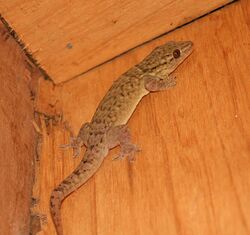Biology:Gehyra oceanica
| Gehyra oceanica | |
|---|---|

| |
| Scientific classification | |
| Domain: | Eukaryota |
| Kingdom: | Animalia |
| Phylum: | Chordata |
| Class: | Reptilia |
| Order: | Squamata |
| Family: | Gekkonidae |
| Genus: | Gehyra |
| Species: | G. oceanica
|
| Binomial name | |
| Gehyra oceanica (Lesson, 1830)
| |
| Synonyms | |
| |
Gehyra oceanica, also known as the Oceania gecko or Pacific dtella, is a species of gecko in the genus Gehyra. The larger Gehyra vorax (voracious gecko) of Fiji, Vanuatu and New Guinea has sometimes been included in this species, but is now treated as distinct.[1]
The species is native to New Guinea and a number of islands in Melanesia, Micronesia and Polynesia. It has also been widely introduced across the islands of the Pacific, reaching as far as the Marquesas Islands in Polynesia (where the species was first collected for science), although the extent to which the species has been introduced by human intervention is a matter of some debate. There are two apparent populations, a northern one in Micronesia and a southern one in Melanesia and Polynesia.[2] There are also records of the species in New Zealand and Hawaii, but the species has apparently not become established there.[1]
The species is generally arboreal and nocturnal. The diet includes insects and even smaller geckos. Some stomachs have also been found with seeds from fruit.[1] It reproduces sexually, and unlike some other geckos in its genus its eggs are non-adhesive. The species shares communal nests of not more than twelve eggs in each, with only two eggs being laid by a female at a time. These eggs have a long incubation time, up to 115 days.[2] It inhabits a range of habitats including plantations, gardens, and disturbed and undisturbed forests.[3] The species will also feed inside human buildings, but is not described as commensal.[1]
References
- ↑ 1.0 1.1 1.2 1.3 Beckon, William N. (1992). "The Giant Pacific Geckos of the Genus Gehyra: Morphological Variation, Distribution, and Biogeography". Copeia 1992 (2): 443–460. doi:10.2307/1446204.
- ↑ 2.0 2.1 Fisher, Robert N. (1997). "Dispersal and Evolution of the Pacific Basin Gekkonid Lizards Gehyra oceanica and Gehyra mutilata". Evolution 51 (3): 906–921. doi:10.2307/2411165.
- ↑ Lever, Christopher (2003). Naturalized reptiles and amphibians of the world. Oxford biology readers. Oxford University Press. pp. 65–66. ISBN 978-0-19-850771-0. https://books.google.com/books?id=igNPuKzHfG0C&pg=PA65.
Wikidata ☰ Q978926 entry
 |

